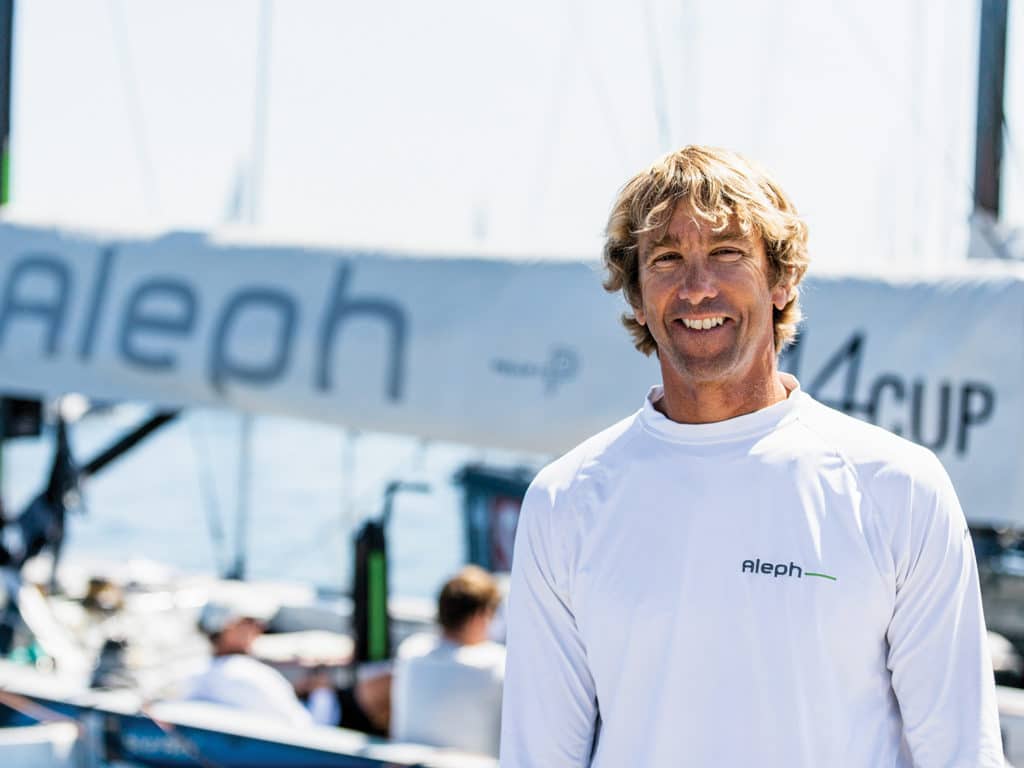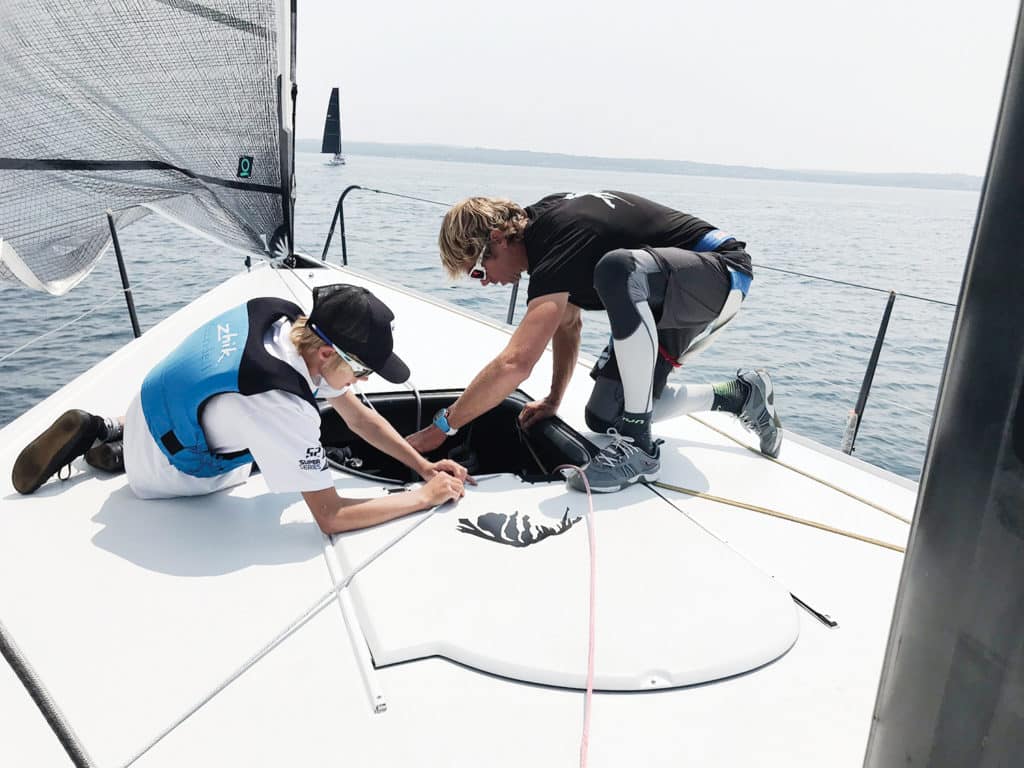
In late July, Greg Gendell, 49, is driving to the airport. Again. He’s outbound for another regatta, but this time he’s headed to little ol‘ Traverse Bay, Michigan, rather than Palma, Portugal, Sweden or the many other exotic racing locales he frequents. So far this summer he’s been to Europe a half-dozen times to command the bow of Quantum Racing in the 52 Super Series and Aleph in the 44 Cup regattas, the two top-tier pro-sailing circuits. Not long ago he was a solo traveler to his sailing gigs, but on this particular airport run, his 11-year-old son is riding shotgun as he navigates the airport parking garage. This weekend, Gendell 2.0 will be watching his pops do his thing on the bow of the 52-footer Interlodge, just as the elder has done for nearly two decades as one of the best in the business.
Are you one of the younger bowmen on the pro-sailing circuits these days? Because you sure look it.
I don’t know about that. It’s funny because growing up, it was always the youngest guy that got sent forward. But the teams I sail with have lots of veterans, and I’m no longer one of the youngest.
How do you stay so fit?
I still prefer swimming and riding the bike, and I do a bit of yoga before sailing each day—a 10-minute routine to loosen up. In the gym, I do a lot of upper-body and core-stability stuff. I spend a lot of time on the Swiss ball. Fitness for me has always been important, but as I age, especially, it’s one of the things I’m known for, arriving ready to go, which I take seriously.
You still fit the mold for a bowman, physically, but as raceboats get bigger, do they need bigger guys?
For the 52 Super Series weigh-in I’m at 172 pounds. A lot of the other bowmen are built like me: wiry and tall and thin, and it seems like that’s still the form. I’ve sailed on some bigger boats, such as Comanche, and to be honest, I wasn’t quite big enough for plugging in the big furlers and wrestling the zeros and stuff. I got it done, but it’s much more physical for sure with the big gear.
Are you a card-carrying member of the Facebook Foredeck Union group?
I’m not…no. I don’t do social media. About nine years ago I sailed a Mumm 30 regatta with a bunch of college kids and I was thinking to myself then that I should do the Facebook thing. I felt the generation gap at that point, but still haven’t done it.
How many days of sailing so far this year?
I’ll probably do about 160 days total. I turn stuff down because my wife works. She has the real job. A lot of guys chase every possible day they can, but fortunately I don’t have to. The 52s and the 44s work well together in that I can do both. The 52 has been my priority for the past 12 years and I’ve been in the 44 class for five years. Those are my two priority teams, and I come and go on a few other programs. I do some superyacht stuff as well.
With all the precision electronics in the hands of those at the back of the boat, is there less pressure on you for the start?
It depends. You’ve got the navigator with the computer, my input from the bow, and their own gut feel. They have to take all three and decide what to do. A lot of times they still look to me for the start. I guess it’s probably gotten easier, but there is still a lot of pressure because you’re so close to the starting line; I’m talking one-tenth of a second of accuracy whether you’re bang on or called over. When the computer isn’t working—which happens sometimes—they’ll tell me there are no electronics and it’s all on me. When I know that, I actually take total control and I like it. I get my inputs and talk with confidence and fuel off the adrenaline.

With string take-down systems and no spinnaker pole to deal with, is it much easier for you?
Things happen quickly on the 52 and the kite drops in five seconds, so that’s definitely easier. We only have one jib halyard and a single luff foil and a lot of times we’ll only take one jib on the boat at a time. The boats, on deck at least, are very simple with super-clean layouts, but down below it’s incredibly complex.
Is this your department as well?
Jared Henderson is the guy that knows all the systems down below, and he’s usually the guy that jumps down there if something goes wrong. I don’t know all the systems well. Six years ago I knew every system, but I haven’t always stayed up with it. I should keep up with it, but at the same time, I know the systems better than the other guys on the boat.
Least favorite part of the job these days?
Time away from the family. But I’m involved with great teams, so it doesn’t ever feel as though I’m punching the clock. We’ve had a lot of success, and when we go sailing I know we have a chance of doing well and winning the regatta, so I’m lucky that way.
Does it ever get old?
I still really enjoy competing at the top level and being in the zone, of having a single purpose with teams and boats I know well. The races are intense, 45 minutes, and while I’m doing that I have such purpose. I like that. Doing it at such a high level is just so much fun.
When the computer isn’t working—which happens sometimes—they’ll tell me there are no electronics and it’s all on me. When I know that, I actually take total control and I like it.
As you go from boat to boat, how do you adapt to the different afterguard styles?
I’ve sailed a lot with Terry [Hutchinson]. He is such a loud communicator. There is no gray area with him. Everybody on the boat, and on the racecourse sometimes, knows what we’re doing. I like that everyone’s on the same page. Coming into a leeward gate, for example, if he doesn’t know which gate, he’ll say, “options open here.” You have no idea which gate you’re going to round, but I like that. On boats where the afterguard goes quiet, you just don’t know and that’s where the team suffers.
What’s your mental checklist in the prestart?
I check the tackline, halyard and the spinnaker hook up. Check, double check and recheck so that I know exactly what it’s going to look like when the hatch opens. There are a lot of little things I’ll cast my eyes over, like how the spin sheet sits on the forestay—and even with two minutes to go, I’ll keep looking at things as I start focusing on the starting line.
Is there anything that catches you off guard these days?
Not much; on the Quantum 52 everything is done quickly and without discussion. We have long offset legs, and we can be one boat length from the offset, and then change our minds about whether it’s a jibe-set or straight set. Coming into the bottom mark, too, we can leave everything until we’re basically at the mark. The string takedown has changed that dramatically. But it can still go bad.
How so?
It comes down to communications coming into the mark. In 25 knots of wind, it’s easy to get behind and out of sync. For example, the grinders have to sheet the jib on a bit, and if the tack of the jib lands outside the bow pulpit, I have to run up and skirt; then we have the jibing hobble, which has to come off— then the guys have to trim the kite in because it’s flapping and load up the string…If it doesn’t happen in a normal rhythm and you drop the kite when it’s collapsed, bad things happen. There’s a lot going on and it’s happening quickly.
What’s your go-to bowman gear these days?
I still like the Ronstan ClearStart watch. It has big numbers and it’s easy to scroll through the functions. I still have a Lirakis harness; in fact, I have three of them. Steve Lirakis hasn’t made harnesses since the early 2000s. I like the way it picks me up, more by the legs and up a bit higher. White sunglasses are definitely my thing. I’m thinking about letting them go, though. The ones I have now are a little obnoxious. I might stick with white, but I have to tone it down a bit. Zhik’s leggings, with the knee pads and sun protection, is what I’ve used about every day and every time I sail. For my knife, I prefer the Leatherman Wave. For 100 bucks, it’s still the best.









